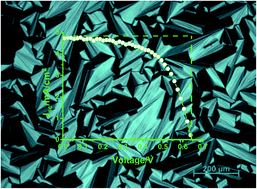Lithium salt–nonionic surfactant lyotropic liquid crystalline gel-electrolytes with redox couple for dye sensitized solar cells†
Abstract
Lithium salt (LiCl, LiBr, LiI, or LiNO3) and a non-ionic surfactant (such as 10-lauryl ether, C12E10) form lyotropic liquid crystalline (LLC) mesophases in the presence of a small amount of water. The mesophases can be prepared as gels by mixing all the ingredients in one pot or in the solution phase that they can be prepared by coating over any substrate where the LLC phase is formed by evaporating excess solvent. The second method is easier and produces the same mesophase as the first method. A typical composition of the LLC phases consists of 2–3 water per salt species depending on the counter anion. The LiI–C12E10 mesophases can also be prepared by adding I2 to the media to introduce an I−/I3− redox couple that may be used as a gel-electrolyte in a dye-sensitized solar cell. Even though the mesophases contain a large amount of water in the media, this does not affect the cell performance. The water molecules in the mesophase are in the hydration sphere of the ions and do not act like bulk water, which is harmful to the anode of the dye-sensitized solar cells (DSSC). There are two major drawbacks of the salt–surfactant LLC mesophases in the DSSCs; one is the diffusion of the gels into the pores of the anode electrode and the other is the low ionic conductivity. The first issue was partially overcome by introducing the gel content as a solution and the gelation was carried in/over the pores of the dye modified titania films. To increase the ionic conductivity of the gels, other salts (such as LiCl, LiBr, and LiNO3) with better ionic conductivity were added to the media, however, those gels behave less effectively than pure LiI/I2 systems. Overall, the DSSCs constructed using the LLC electrolyte display high short circuit current (Isc of around 10 mA), high open circuit voltage (Voc of 0.81 V) and good fill factor (0.69) and good efficiency (3.3%). There is still room for improvement in addressing the above issues in order to enhance the cell efficiency by developing new methods of introducing the gel-electrolytes into the mesopores of the anode electrode.



 Please wait while we load your content...
Please wait while we load your content...